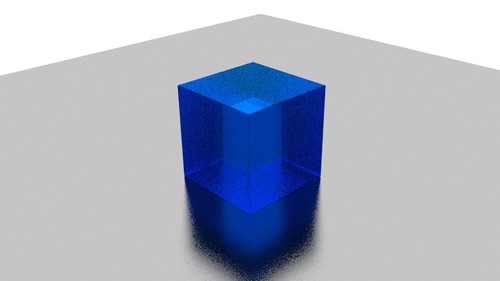Ants on a cube
 There exists a cube in space. Two ants start at two random and distinct corners of the cube and move only along the edges of the cube. If either ant is at a corner, it chooses an edge randomly and moves to an adjacent corner with uniform velocity. The ants make their decisions independently. They start moving simultaneously when the clock is at zero, and move continuously with constant speed. If it is known that an ant traverses a side of the cube in one second, find the expected time elapsed(in seconds) before they meet for the first time. Round your answer off to the nearest integer.
There exists a cube in space. Two ants start at two random and distinct corners of the cube and move only along the edges of the cube. If either ant is at a corner, it chooses an edge randomly and moves to an adjacent corner with uniform velocity. The ants make their decisions independently. They start moving simultaneously when the clock is at zero, and move continuously with constant speed. If it is known that an ant traverses a side of the cube in one second, find the expected time elapsed(in seconds) before they meet for the first time. Round your answer off to the nearest integer.
Liked this? Try similar problems in the set: Ants on an adventure!
The answer is 9.
This section requires Javascript.
You are seeing this because something didn't load right. We suggest you, (a) try
refreshing the page, (b) enabling javascript if it is disabled on your browser and,
finally, (c)
loading the
non-javascript version of this page
. We're sorry about the hassle.
Let's indicate with ∣ s ∣ , s ∈ S , the number of couples of each state indicating where the ants are at. For example, 0 = { ( 1 , 1 ) , ( 2 , 2 ) , . . . , ( 8 , 8 ) } , so ∣ 0 ∣ = 8 . You can figure out from the picture that ∣ E ∣ = 2 4 , ∣ C ∣ = 2 4 , ∣ O ∣ = 8 . Now, we can write the transition matrix P
\displaystyle \textbf{P}= \begin{array}{[cccc]c} \\ E & C & O & 0 \\ \frac{6}{9} & 0 & \frac{2}{9} & \frac{1}{9} & E \\ 0 & \frac{7}{9} & 0 & \frac{2}{9} & C \\ \frac{6}{9} & 0 & \frac{3}{9} & 0 & O \\ 0 & 0 & 0 & 1 & 0 \end{array}
Following the standard theory of Markov chains, we evaluate N = ( I − Q ) − 1
N = ( I − Q ) − 1 = ⎝ ⎛ 9 0 9 0 2 9 0 3 0 2 9 ⎠ ⎞
We define U = u i , for 1 ≤ i ≤ 4 ,as the stochastic vector indicating the probabilities of each state being the starting state. We have
u 1 = P ( E ) = 8 2 − 8 ∣ E ∣ = 5 6 2 4 u 2 = P ( C ) = 8 2 − 8 ∣ C ∣ = 5 6 2 4 u 3 = P ( O ) = 8 2 − 8 ∣ O ∣ = 5 6 8 u 4 = P ( 0 ) = 0
Eventually, the expected value of arriving at the absorbing state is
E [ 0 ] = i = 1 ∑ 3 i = 1 ∑ 3 n i j u i = 5 6 2 4 ⋅ 1 2 + 2 9 ⋅ 5 6 2 4 + 2 2 7 ⋅ 5 6 8 = 9